My Side of The Glass
A Blog by Record Producer Brian Charles
Ask The Alchemist – Oct.1,2013 Inspiration: Nirvana’s “In Utero Album
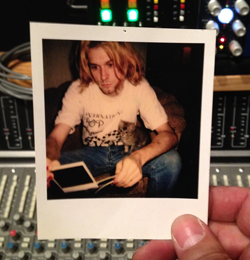 Tuesday Night Recording Club – Oct. 1, 2013 Tuesday Night Recording Club – Oct. 1, 2013Original Song: “Ask The Alchemist” Written by: Aaron Perrino Inspiration: Nirvana’s “In Utero” Album With Musical Contribution From: Aaron Perrino: Vocals Annie Hoffman: Bass Adam Hand: Drums Will Claflin:GuitarProduced & Engineered By: Brian Charles & Annie Hoffman On Tuesday Night, Oct.1, 2013 at Zippah Studios, Boston, MA Visual wizardry: Camera:Jay Weeks Directed & Edited By Will Claflin aka Sacruhlicious |
The week prior to our TNRC “In Utero” session, Annie and I posted some requests on Facebook to try and round up a Tama drum set with a 24″ kick drum, 15 &18″ toms as well as a Gibson RD Artist bass. We’ve made these kind of requests on FB before, and it’s been really helpful. I didn’t however, anticipate some of the reactions to the idea of us tackling “In Utero”. Most people were excited by the idea, but others were pessimistic, and insinuated, that it wasn’t possible to do what they thought we were going to do. It was almost like taboo…how dare we demystify the process of creating this masterpiece. It is for this reason that I feel the need to clear a few things up. First of all, Aaron and I 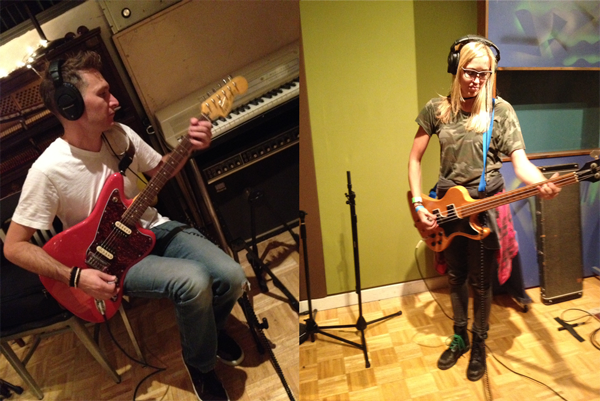 love all of the seminal records that we’ve chosen as themes for every single TNRC session. In fact, that is what fuels our choices. It’s that excitement that makes this worth doing for us. Second, I love learning about how other engineers make records. I typically work out of my own studio, and rarely do I get the chance to compare my methods with the methods of others. Learning and trying new things as an engineer is essential to keeping me interested, and my recordings fresh….as for Aaron, there is no doubt in my mind that writing songs in all of love all of the seminal records that we’ve chosen as themes for every single TNRC session. In fact, that is what fuels our choices. It’s that excitement that makes this worth doing for us. Second, I love learning about how other engineers make records. I typically work out of my own studio, and rarely do I get the chance to compare my methods with the methods of others. Learning and trying new things as an engineer is essential to keeping me interested, and my recordings fresh….as for Aaron, there is no doubt in my mind that writing songs in all of  these different styles is challenging as well as inspiring to him as an artist… invaluable by-products of TNRC. Third…we approach these recordings with the utmost respect, and have a great time employing and sharing the techniques that we researched…anyone who has read my past blogs, should realize this. I learned a lot this week researching how Steve Albini recorded one of my favorite records of all time. Now, I’ve met Steve on a number of occasions, specifically at audio conferences, where he’s participated on panels and such. We’ve even had a degree of separation over the years working with some of the same musicians and spin-offs of related bands. He’s opinionated at times, seems to possess a general dislike of music industry establishment, and he also has definite ideas about his roles as an engineer / “producer”. Steve refused to take a royalty for the recording of In Utero, he felt it was wrong to benefit from the artist’s intellectual property. Instead he was paid a flat fee (a small fraction of the money that he would have made as a royalty beneficiary). It is, in my “mind impossible to not respect him as a decent human being. Not having an “agenda” allows Steve to make records that are honest to the band, and focus on capturing the true essence of (not only) the sound, but the spir these different styles is challenging as well as inspiring to him as an artist… invaluable by-products of TNRC. Third…we approach these recordings with the utmost respect, and have a great time employing and sharing the techniques that we researched…anyone who has read my past blogs, should realize this. I learned a lot this week researching how Steve Albini recorded one of my favorite records of all time. Now, I’ve met Steve on a number of occasions, specifically at audio conferences, where he’s participated on panels and such. We’ve even had a degree of separation over the years working with some of the same musicians and spin-offs of related bands. He’s opinionated at times, seems to possess a general dislike of music industry establishment, and he also has definite ideas about his roles as an engineer / “producer”. Steve refused to take a royalty for the recording of In Utero, he felt it was wrong to benefit from the artist’s intellectual property. Instead he was paid a flat fee (a small fraction of the money that he would have made as a royalty beneficiary). It is, in my “mind impossible to not respect him as a decent human being. Not having an “agenda” allows Steve to make records that are honest to the band, and focus on capturing the true essence of (not only) the sound, but the spir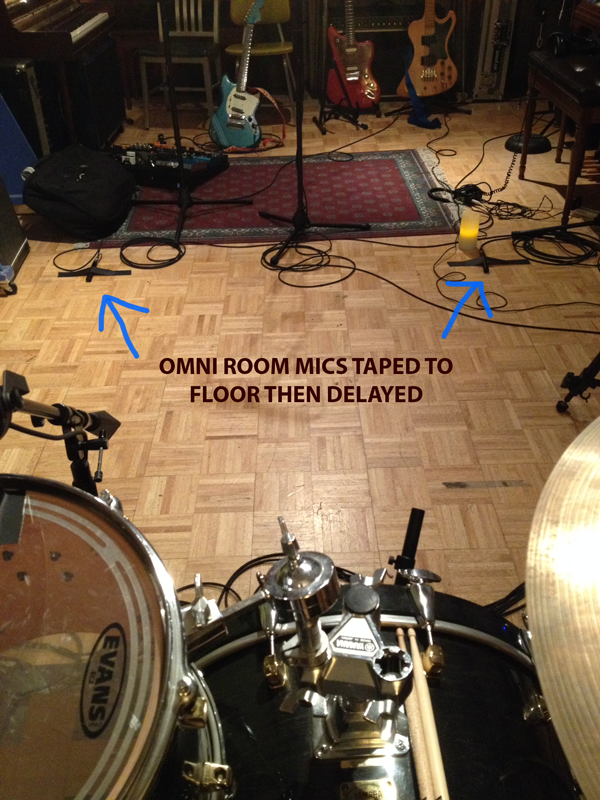 it of a band. I feel that he did this with Nirvana. All of the controversy that existed 20 years ago about the label not liking this record seems ridiculous in hindsight. Honest albums stand the test of time. records made with production gimmicks and the intent on “selling units” survive only as pieces of nostalgia…the song that is important only because reminds you of 3rd grade or something like that. Steve made an honest album, and it certainly stands the test of time. I enjoyed employing some of the recording techniques that he used. It’s worth noting that Steve is known for utilizing the natural ambience of the space he’s recording in. You can hear this in some of his past records like The Pixies “Surfer Rosa” and The Breeders “Pod”. This was apparently a big factor in Nirvana’s choice to it of a band. I feel that he did this with Nirvana. All of the controversy that existed 20 years ago about the label not liking this record seems ridiculous in hindsight. Honest albums stand the test of time. records made with production gimmicks and the intent on “selling units” survive only as pieces of nostalgia…the song that is important only because reminds you of 3rd grade or something like that. Steve made an honest album, and it certainly stands the test of time. I enjoyed employing some of the recording techniques that he used. It’s worth noting that Steve is known for utilizing the natural ambience of the space he’s recording in. You can hear this in some of his past records like The Pixies “Surfer Rosa” and The Breeders “Pod”. This was apparently a big factor in Nirvana’s choice to 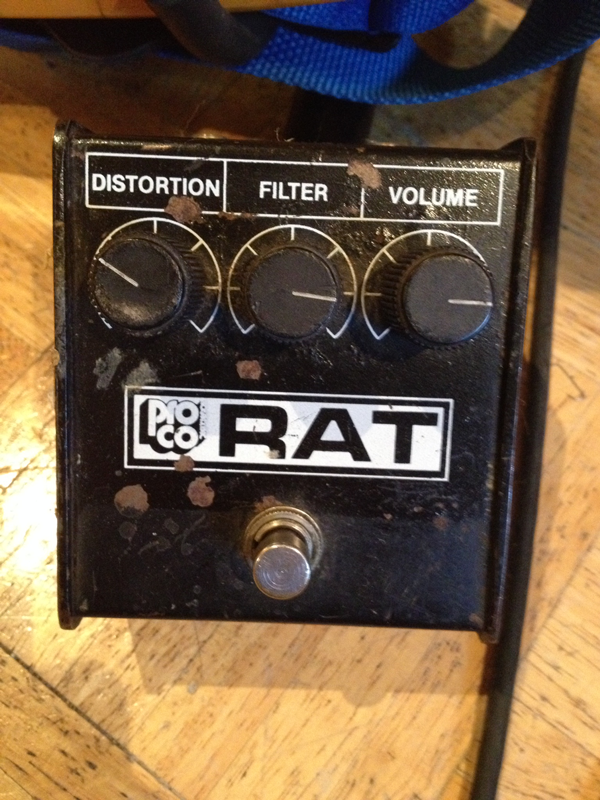 work with him. Having heard Steve talk on the subject of “recording the room”, specifically on the drums, I was excited to apply his technique in our space. We took two microphones with “Omni” settings and gaffer taped them to the floor about 10-12 feet in front of the drum set. We then delayed the signals from those mics by 30 milliseconds using an Eventide H3000. Taping the mics to the floor imparts the character of a “boundary mic”, pulling in sympathetic signals of the kick drum, also, having them placed so low, allows you to use more room to dry signal before the cymbals become overbearing. The success of this technique is heavily dependent on the drums sounding good in the room. You NEED a drummer who knows how to make drums sound good. That sounds strange, but trust me, it’s very real. Our work with him. Having heard Steve talk on the subject of “recording the room”, specifically on the drums, I was excited to apply his technique in our space. We took two microphones with “Omni” settings and gaffer taped them to the floor about 10-12 feet in front of the drum set. We then delayed the signals from those mics by 30 milliseconds using an Eventide H3000. Taping the mics to the floor imparts the character of a “boundary mic”, pulling in sympathetic signals of the kick drum, also, having them placed so low, allows you to use more room to dry signal before the cymbals become overbearing. The success of this technique is heavily dependent on the drums sounding good in the room. You NEED a drummer who knows how to make drums sound good. That sounds strange, but trust me, it’s very real. Our 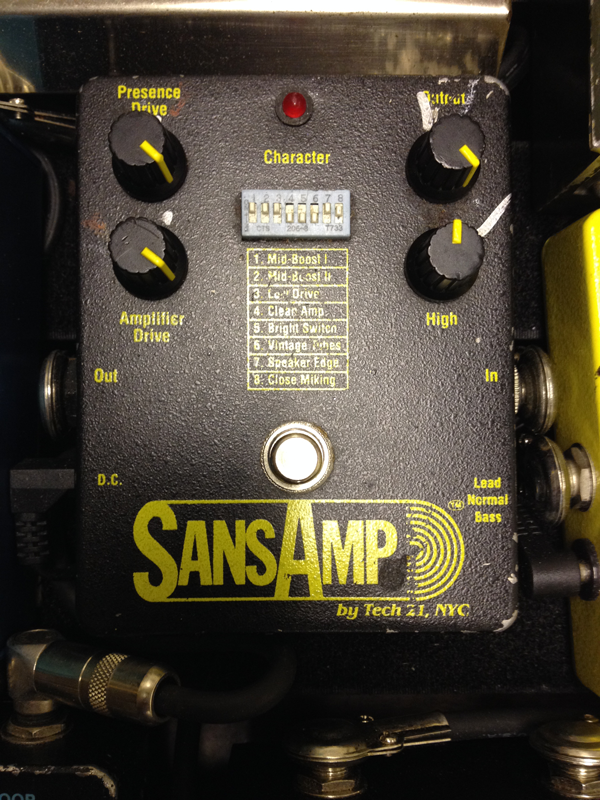 drummer tonight – Adam Hand from “The Field Effect” plays with great energy, and knows how to hit for sure. He played a kit with smaller drums than the one that Dave Grohl used on “In Utero”. We had an identical kit lined up, but things fell through at the last minute (boo!). We made-do with one of our house kits…though it would have been nice to have a 24″ power kick drum to demonstrate this sound. We mic’d the kit with condenser mics, all around except for the front-side kick mic (AKG D112). We mic’d the batter side with a small condenser (KSM127), toms with ATM3525, AKG-C414 over heads and on snare – a Milab DC-96B (no bottom mic). Steve Albini isn’t a fan of using Shure SM-57s…in fact, I think he hates them. Our bassist tonight was “first-stringer” Annie Hoffman. In addition to being a staff engineer at Zippah, she’s also the bassist in “The Field Effect”. She and Adam make a ferocious rhythm section (and a cute couple). We managed to round up a Gibson RD Artist bass, like the one that Krist Novoselic played (thanks Jared Egan!). It looks like something out of Picasso’s “Guernica” painting and weighs a ton. All I could think of was how much this bass must have hurt when Krist threw it in the air and it came down on his head (1992 VMA Awards). We ran it into a Rat pedal from 1991(see pic for settings), and then into an Ampeg V4B and 8X8 cabinet. We mic’d the cabinet with an EV RE-20 dynamic mic and a Shure SM-81 small condenser. This technique of high mic/ Lo mic is one that I’ve heard Albini mention. We only compressed the “Lo mic”… The result was a VERY Nirvana-like bass sound…almost uncanny. It’s well documented that Kurt mainly used Fender Mustang guitars. He apparently liked the slightly shorter scale as well as the fact that he was able to find a few left-handed models. Kurt’s guitar technician performed quite a few mods to Kurt’s Mustangs including blocking up the tremolo system as well as installing a humbucker in the bridge position. During the recording of “In Utero”, Kurt also owned a handful of Stratocasters, a couple of Jaguars, a Univox (Mosrite copy) and some other odd-balls. Being a “Lefty”, he took what he could get. Between the completion of recording and the tour for the album, Fender made Kurt a signature Guitar (Jagstang), that he used briefly during Nirvana’s European tour in ’94. There are many websites documenting Kurt’s gear, pedals…even settings on his pedals. We used these resources to put together a couple of different guitar rigs for our recording. The main setup was a 1969 Fender Mustang in “Competition Blue”. Kurt pretty much made this guitar famous in the video for “Smells Like Teen Spirit”. We also had a new Fender (Squier) Mustang with a factory Duncan Humbucker in the bridge position that we borrowed from Mr. Music. Will Claflin (Dear Leader), guitarist for the evening…also our TNRC video wizard liked it so much, that he ended up buying it. We had a Sans-Amp Classic pedal and a Boss DS-1 (Kurt used a similar DS-2 for In Utero). A 70,s Fender Twin Reverb mic’d in a “hi-lo” configuration with a ribbon mic (Fostex RP-77) and a Small condenser (Rupert Neve/SE RN-17). We found some Kurt Sans-Amp settings…first 3 dip switches up, 2nd 3switches down…output, presence drive and amp drive – on full…high (treble) at 12 o’clock. We also found some settings (online at http://www.kurtsequipment.com) which we used as a guide for the amp and Boss pedal. Kurt also used a Mesa Boogie “Studio Preamp” with a Crest power amp…this was his main live rig, as it travelled well in rack cases. I have a Mesa Nomad, with the same basic preamp controls and on board graphic EQ. I decided to try it out with a Marshall cabinet (1960a) and although, not exact to Kurt’s pre/power amp setup, it had a certain midrange “burn” that smelled like “In Utero” (sorry for the bad pun). We ended up using Will’s live guitar take (with the Boss DS-1) that went down with the bass and drums. We then overdubbed an additional lead track with the Sans Amp…both using the Twin Reverb amp. We then recorded a lead/ feedback track through the Mesa…Will played some rhythm on this as well. I think he had a lot of fun laying down some nice tracks with attitude. Aaron’s vocals were recorded with two U47 tube mics…one close, and one farther away to use as room ambience. You can clearly hear this technique in use on “In Utero”. Using natural room sounds on the vocals and drums brings a certain energy to the recording that can’t be achieved the same way with the use of room simulators. And although the room we recorded in is different from the room at Pachyderm studios, our recording still demonstrates the attributes of this technique. We recorded to a Studer A-80 MK IV 2″ tape machine at 30ips, and used our Neotek console preamps for all signals except the bass which went through Skibbe Electronics (Flickinger preamps), and a Tube-Tech compressor (on the “lo mic”). I hope that you enjoy the video and song from this evening. I also hope that you get a chance to try some of these techniques out yourself -bc drummer tonight – Adam Hand from “The Field Effect” plays with great energy, and knows how to hit for sure. He played a kit with smaller drums than the one that Dave Grohl used on “In Utero”. We had an identical kit lined up, but things fell through at the last minute (boo!). We made-do with one of our house kits…though it would have been nice to have a 24″ power kick drum to demonstrate this sound. We mic’d the kit with condenser mics, all around except for the front-side kick mic (AKG D112). We mic’d the batter side with a small condenser (KSM127), toms with ATM3525, AKG-C414 over heads and on snare – a Milab DC-96B (no bottom mic). Steve Albini isn’t a fan of using Shure SM-57s…in fact, I think he hates them. Our bassist tonight was “first-stringer” Annie Hoffman. In addition to being a staff engineer at Zippah, she’s also the bassist in “The Field Effect”. She and Adam make a ferocious rhythm section (and a cute couple). We managed to round up a Gibson RD Artist bass, like the one that Krist Novoselic played (thanks Jared Egan!). It looks like something out of Picasso’s “Guernica” painting and weighs a ton. All I could think of was how much this bass must have hurt when Krist threw it in the air and it came down on his head (1992 VMA Awards). We ran it into a Rat pedal from 1991(see pic for settings), and then into an Ampeg V4B and 8X8 cabinet. We mic’d the cabinet with an EV RE-20 dynamic mic and a Shure SM-81 small condenser. This technique of high mic/ Lo mic is one that I’ve heard Albini mention. We only compressed the “Lo mic”… The result was a VERY Nirvana-like bass sound…almost uncanny. It’s well documented that Kurt mainly used Fender Mustang guitars. He apparently liked the slightly shorter scale as well as the fact that he was able to find a few left-handed models. Kurt’s guitar technician performed quite a few mods to Kurt’s Mustangs including blocking up the tremolo system as well as installing a humbucker in the bridge position. During the recording of “In Utero”, Kurt also owned a handful of Stratocasters, a couple of Jaguars, a Univox (Mosrite copy) and some other odd-balls. Being a “Lefty”, he took what he could get. Between the completion of recording and the tour for the album, Fender made Kurt a signature Guitar (Jagstang), that he used briefly during Nirvana’s European tour in ’94. There are many websites documenting Kurt’s gear, pedals…even settings on his pedals. We used these resources to put together a couple of different guitar rigs for our recording. The main setup was a 1969 Fender Mustang in “Competition Blue”. Kurt pretty much made this guitar famous in the video for “Smells Like Teen Spirit”. We also had a new Fender (Squier) Mustang with a factory Duncan Humbucker in the bridge position that we borrowed from Mr. Music. Will Claflin (Dear Leader), guitarist for the evening…also our TNRC video wizard liked it so much, that he ended up buying it. We had a Sans-Amp Classic pedal and a Boss DS-1 (Kurt used a similar DS-2 for In Utero). A 70,s Fender Twin Reverb mic’d in a “hi-lo” configuration with a ribbon mic (Fostex RP-77) and a Small condenser (Rupert Neve/SE RN-17). We found some Kurt Sans-Amp settings…first 3 dip switches up, 2nd 3switches down…output, presence drive and amp drive – on full…high (treble) at 12 o’clock. We also found some settings (online at http://www.kurtsequipment.com) which we used as a guide for the amp and Boss pedal. Kurt also used a Mesa Boogie “Studio Preamp” with a Crest power amp…this was his main live rig, as it travelled well in rack cases. I have a Mesa Nomad, with the same basic preamp controls and on board graphic EQ. I decided to try it out with a Marshall cabinet (1960a) and although, not exact to Kurt’s pre/power amp setup, it had a certain midrange “burn” that smelled like “In Utero” (sorry for the bad pun). We ended up using Will’s live guitar take (with the Boss DS-1) that went down with the bass and drums. We then overdubbed an additional lead track with the Sans Amp…both using the Twin Reverb amp. We then recorded a lead/ feedback track through the Mesa…Will played some rhythm on this as well. I think he had a lot of fun laying down some nice tracks with attitude. Aaron’s vocals were recorded with two U47 tube mics…one close, and one farther away to use as room ambience. You can clearly hear this technique in use on “In Utero”. Using natural room sounds on the vocals and drums brings a certain energy to the recording that can’t be achieved the same way with the use of room simulators. And although the room we recorded in is different from the room at Pachyderm studios, our recording still demonstrates the attributes of this technique. We recorded to a Studer A-80 MK IV 2″ tape machine at 30ips, and used our Neotek console preamps for all signals except the bass which went through Skibbe Electronics (Flickinger preamps), and a Tube-Tech compressor (on the “lo mic”). I hope that you enjoy the video and song from this evening. I also hope that you get a chance to try some of these techniques out yourself -bc |

